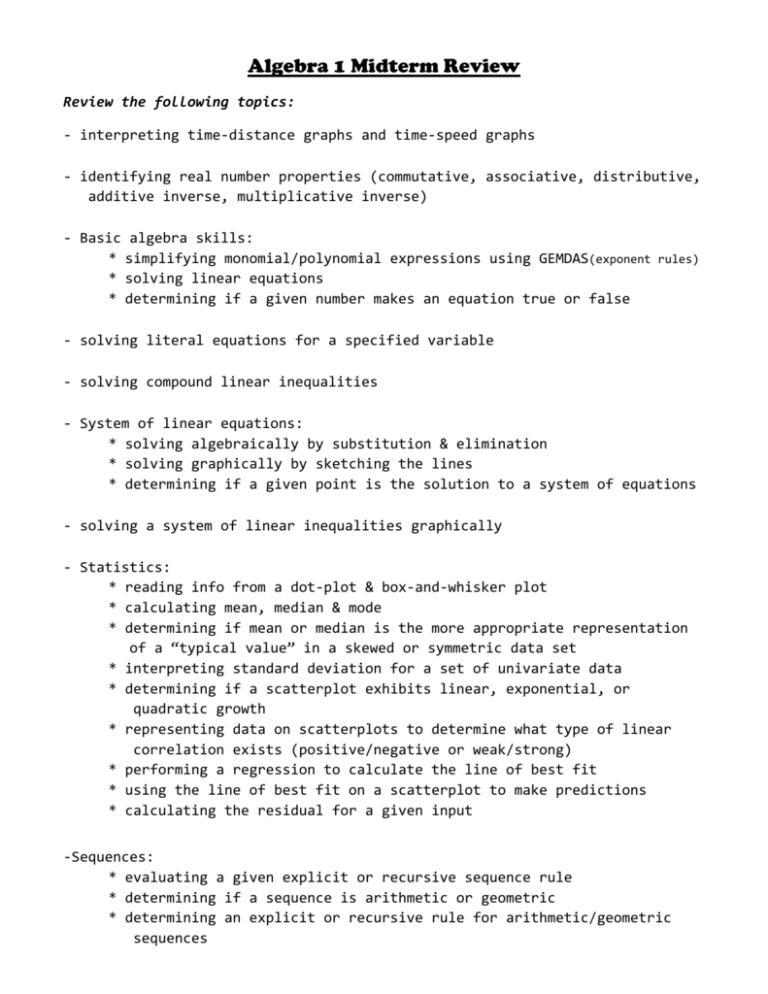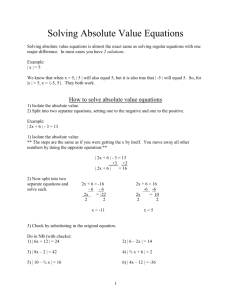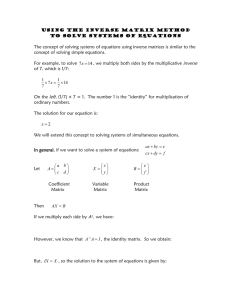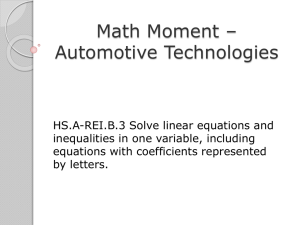Algebra 1 Midterm Review
advertisement

Algebra 1 Midterm Review Review the following topics: - interpreting time-distance graphs and time-speed graphs - identifying real number properties (commutative, associative, distributive, additive inverse, multiplicative inverse) - Basic algebra skills: * simplifying monomial/polynomial expressions using GEMDAS(exponent rules) * solving linear equations * determining if a given number makes an equation true or false - solving literal equations for a specified variable - solving compound linear inequalities - System of linear equations: * solving algebraically by substitution & elimination * solving graphically by sketching the lines * determining if a given point is the solution to a system of equations - solving a system of linear inequalities graphically - Statistics: * reading info from a dot-plot & box-and-whisker plot * calculating mean, median & mode * determining if mean or median is the more appropriate representation of a “typical value” in a skewed or symmetric data set * interpreting standard deviation for a set of univariate data * determining if a scatterplot exhibits linear, exponential, or quadratic growth * representing data on scatterplots to determine what type of linear correlation exists (positive/negative or weak/strong) * performing a regression to calculate the line of best fit * using the line of best fit on a scatterplot to make predictions * calculating the residual for a given input -Sequences: * evaluating a given explicit or recursive sequence rule * determining if a sequence is arithmetic or geometric * determining an explicit or recursive rule for arithmetic/geometric sequences - Functions: * evaluating a function (algebraically, from a graph, table, list or mapping) * determining if a relation represents a function * stating the domain and range of a function When you see the words. . . This is what you should think of doing Find the solution set Solve for the variable in the equation or inequality. Use inverse operations to isolate the variable. Write a polynomial in standard form Write the terms such that the exponents are in descending order. Simplify an expression Follow GEMDAS. An expression is fully simplified when: - all coefficients of polynomials have been distributed - all terms have been raised to their exponent - like terms have been combined There’s an assumption here that you know HOW to work with exponents!! Solve a literal equation for a specified variable A literal equation contains multiple variables. Your job is to isolate the specified variable using inverse operations. Evaluate an expression Plug in a specific number for the variable in an expression then simplify. Represent a scenario as a time-distance graph Sketch as piecewise function. Whenever the scenario changes speed, the slope of the lines change. Solve a system of linear equations using the substitution method Isolate one of the variables in one of the equations. Substitute the isolated variable’s equivalent into the second equation. Solve for the remaining variable. Solve for the other remaining variable. Solve a system of linear equations using the elimination method Write the two equations up so that like terms line up. Choose which variable you want to cancel out (eliminate). Multiply an equation (if needed) by a nonzero constant so that the variable you chose will cancel out. Add the two equations down so they create one equation. Solve for the remaining variable. Solve for the other remaining variable. Solve a system of linear equations graphically Graph and label each linear equation. Mark where the two equations intersect. State the point of intersection (which is the solution!) Solve a linear inequality Isolate the variable. Remember to flip the direction of the inequality symbol when dividing/multiplying by a negative # Solve a compound inequality Separate the compound inequality into two single inequalities using the word AND or OR (depends on the problem). Solve each inequality separately. Determine if a given value is in a solution set Substitute the possible solution into the equation/inequality to check if the # makes the equation/inequality true Determine if a sequence is arithmetic or geometric If the sequence changes by a constant difference (ie, the same # was added over and over) then the sequence is arithmetic. If the sequence changes by a constant ratio (ie, the same # was multiplied over and over) then the sequence is geometric. Determine a recursive rule for a sequence Express an in terms of an – 1 Determine an explicit rule for a sequence Express an in terms of n Determine the strength/direction of a scatterplot’s correlation Examine the scatterplot. The closeness of the points indicates the strength of the linear relationship. The slope of the points indicates the direction. Calculate the equation for the line of best fit Perform a regression on the graphing calculator. (Input data into lists, then go to STAT–CALC–LINREG ax+b Calculate the residual for a given input Actual y-value Determine which measure of central tendency best represents a “typical” value in a data set If the data is skewed, then outliers are present. Outliers distort the mean, so the median is a better measure to use. - predicted y-value (from the line of best fit) If the data is symmetric, then the mean has not been distorted by outliers. The mean or the median would be fine to use as the “typical” value but the mean is more common. Estimate standard deviation If univariate data is quite spread out (varied) then the standard deviation is high. If the univariate data is not spread out, then the standard deviation is low. Determine if a relation is a function Examine the inputs (x-values). If an input has more than one output, then the relation is NOT a function. In other words, each input must not repeat. State the domain of a function List out all of the inputs. State the range of a function List out all of the outputs. Evaluate a function A function rule will be given (an equation, a mapping, a graph, etc). You will be given an input and have to state the output associated with it. Solve algebraically Create an equation to model the situation. Identify what the variable represents. Solve for said variable. Make sure it seems logical in the constraints of the problem. Justify Show/explain how you arrived at your answer. Not limited to algebraic solution.









